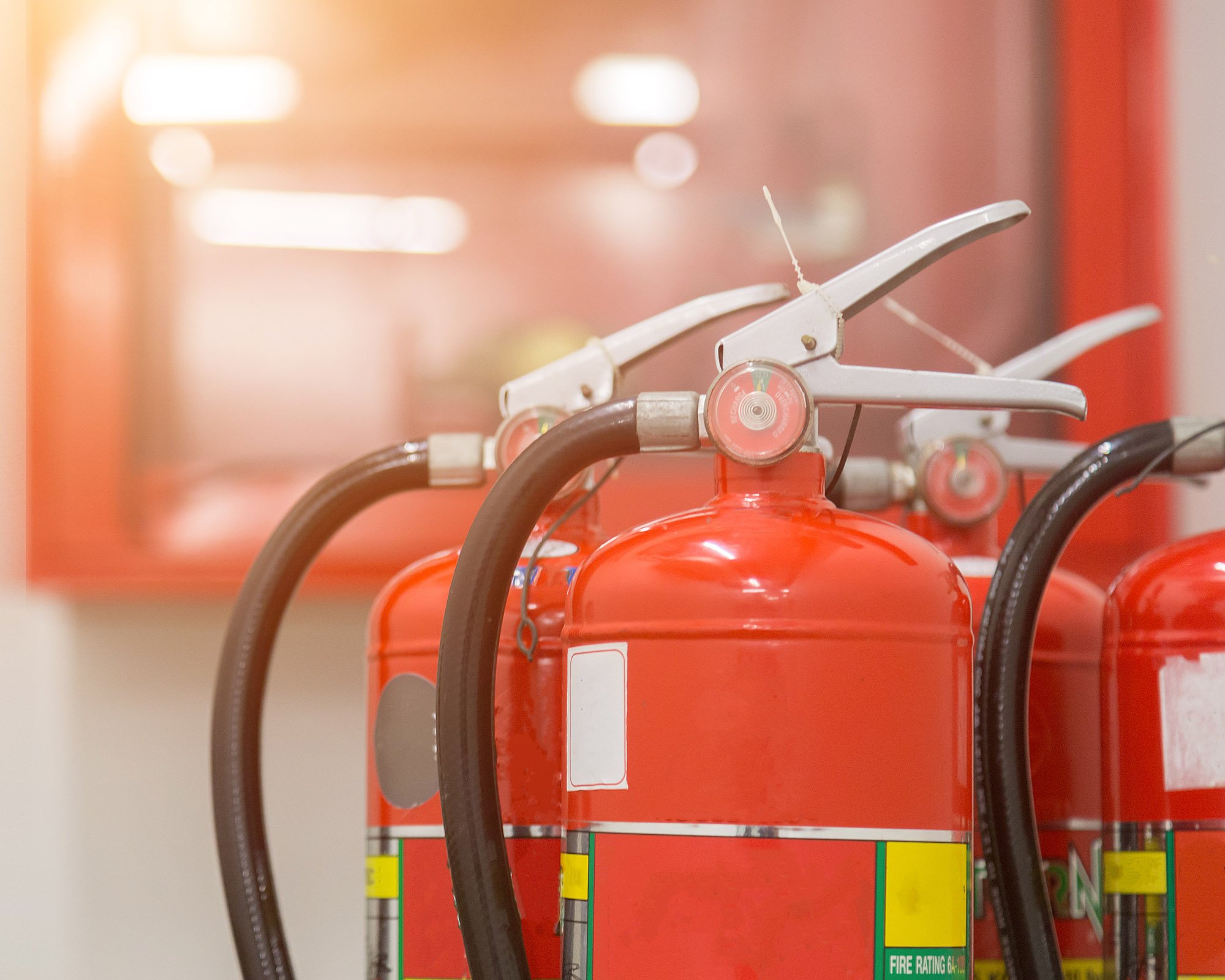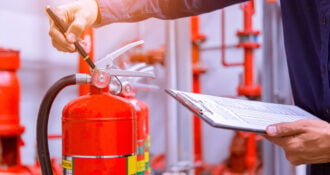Fire safety is a critical concern in both residential and commercial spaces. One of the most essential tools for fire safety is the fire extinguisher. This informative guide will explore the world of fire extinguisher types and help you understand your options. Whether you’re a homeowner, business owner, or just someone interested in fire safety, this guide will give you the knowledge to make informed decisions about fire extinguishers.
Understanding Fire Extinguishers
Before delving into the different types of fire extinguishers, it’s crucial to understand what fire extinguishers are and how they work. Fire extinguishers are portable devices designed to control or extinguish small emergency fires. They operate by releasing an extinguishing agent that suppresses the fire.
Fire extinguishers are not a one-size-fits-all solution. They are categorised based on the types of fires they can effectively combat. Understanding these categories is essential for choosing the right fire extinguisher in an emergency. There are five primary types of fire extinguishers, each designated by a letter and colour code:
Types of Fire Extinguishers
Water Fire Extinguishers: marked with a red label, are designed for Class A fires, which involve ordinary and easily combustible materials such as paper, wood and textiles. These extinguishers work by cooling the fire and reducing the temperature of the burning material.
CO2 (Carbon Dioxide) Fire Extinguishers: indicated by a black label, are effective against Class B fires, which involve flammable liquids like gasoline, oil, and grease, as well as Class C fires caused by electrical equipment. Carbon dioxide displaces oxygen, which starves the fire of the oxygen it needs to burn. Ideal for switchboards, server rooms or where expensive medical or electrical equipment is installed. Very clean with no residue.
Foam Fire Extinguishers: identifiable by a blue label, are versatile extinguishers that can combat Class A and B fires. The foam creates a barrier that seals off the fire’s oxygen supply, suppressing the flames effectively.
Dry Chemical Fire Extinguishers: identifiable by a white label, are suitable for Class A, B, and C fires. They work by breaking down the chemical reaction of the fire and creating a barrier between the flames and the fuel source.
Wet Chemical Fire Extinguishers: identifiable by an oatmeal label and are specifically designed for Class F fires involving cooking oils and fats. These extinguishers create a cooling effect and form a barrier on the surface of the hot oil to prevent re-ignition.
Each type of fire extinguisher has a unique role in addressing specific fire hazards. Understanding the types and their applications is the first step in choosing the right fire extinguisher for your needs.
Choosing the Right Fire Extinguisher
Selecting the appropriate fire extinguisher for your environment is crucial. Here are some factors to consider:
Fire Classifications
Understanding the types of fires you will most likely encounter in your location is essential for choosing the right fire extinguisher. Fires are classified into five main categories:
- Class A: Fires involving ordinary combustibles like wood, paper, and textiles.
- Class B: Fires fueled by flammable liquids like gasoline, oil, and grease.
- Class C: Fires caused by flammable gases.
- Class D: Fires involving combustible metals like magnesium and titanium.
- Class E: Fires involving energised electrical equipment.
- Class F: Fires that originate from cooking oils and fats.
Each fire class corresponds to specific fire extinguisher types, effectively tackling the respective fires.
Location
Consider where the fire extinguisher will be placed and the potential fire hazards in that area. For instance, a wet chemical fire extinguisher in a kitchen is a wise choice due to the risk of cooking oil fires. In an industrial setting, a dry chemical fire extinguisher may be more suitable for dealing with various fire hazards.
Size and Weight
Ensure you can handle the fire extinguisher comfortably. Larger extinguishers typically contain more extinguishing agents and offer longer discharge times but may be heavier and more challenging to manoeuvre.
Fire Extinguisher Usage Guidelines
Using a fire extinguisher correctly is as important as choosing the right type. Remember the PASS acronym:
P: Pull the Pin
In an emergency, the first thing to do is to pull the pin at the top of the extinguisher. This pin prevents accidental discharge.
A: Aim at the Base of the Fire
When using the fire extinguisher, always aim at the base of the fire. The base is where the fuel source is located. Directing the extinguishing agent at the flames won’t be effective.
S: Squeeze the Handle
Squeeze the handle or trigger to release the extinguishing agent. Keep a firm grip while doing so.
S: Sweep from Side to Side
Move the nozzle from side to side in a sweeping motion. This ensures that the extinguishing agent covers the entire fire area. Continue until the flames are completely out.
Practice using a fire extinguisher (if safe to do so) to familiarise yourself with the process. Being prepared and knowing how to respond to a fire emergency can make all the difference.
Maintenance and Inspection
Regular maintenance and inspection are vital to ensure your fire extinguisher is in working condition when you need it most. Here are some important maintenance tips:
Monthly Visual Inspection
- Check that the fire extinguisher is in its designated location.
- Ensure that the pressure gauge (if present) shows the correct pressure range.
- Verify that the safety pin is intact, sealing the extinguisher.
Annual Professional Inspection
- Schedule an annual inspection by a qualified technician to check the extinguisher for any signs of damage or wear.
- Ensure the extinguisher has not exceeded its service life, as indicated on the label.
Hydrostatic Testing
All fire extinguishers, particularly CO2 and water-based extinguishers, require hydrostatic testing every five years to assess the pressure vessel’s integrity. A certified professional should perform this.
By adhering to these maintenance and inspection practices, you can increase the reliability of your fire extinguisher and ensure it is ready for use when necessary.
Fire Safety in Specific Environments
Different environments pose unique fire risks. Let’s explore how to tailor your fire safety measures to specific settings:
Home Fire Safety
For homeowners, fire safety begins with the right fire extinguisher. Consider placing a dry chemical fire extinguisher in the kitchen to address potential cooking-related fires. Preferably have ABE fire extinguishers in easily accessible locations to cover a range of fire types. Ensure that everyone in your home knows the location of these extinguishers and how to use them. In addition, it is advisable to have a fire blanket, ideally, this would be a 1.2 x 1.8 metre fire blanket; anything smaller is not advised.
Office and Commercial Spaces
In office and commercial settings, fire safety is a collective responsibility. Conduct fire drills regularly and ensure employees know the location of fire extinguishers and how to use them. Depending on the specific fire hazards in your workplace, you may need various types of fire extinguishers strategically placed throughout the premises.
Restaurant Fire Safety
Restaurants face a unique fire hazard with cooking oils and fats. For kitchen areas, wet chemical fire extinguishers are essential to combat Class F fires. These extinguishers should be located near cooking equipment. Additionally, having ABE and CO2 fire extinguishers in other restaurant areas can provide coverage for other fire types. Ideally, it is preferable to have a CO2 instead of an ABE in the kitchen as the powder will contaminate all exposed food and plates in the food prep area.
Industrial and Manufacturing Facilities
Industrial settings often involve a wide range of fire hazards, including flammable liquids, electrical equipment, and combustible materials. A comprehensive fire safety plan is crucial, including installing different fire extinguishers in key locations. Regular training for employees on the use of these extinguishers is also essential.
Retail Stores and Shopping Centers
Retail spaces should have easily accessible fire extinguishers, especially in areas with electrical equipment or flammable materials. ABE fire extinguishers are typically suitable for these environments.
Frequently Asked Questions
Q1. What is the Australian standard for fire extinguishers?
A. fire extinguishers must comply with the AS 1851-2012 standard in Australia. This standard outlines fire extinguisher design, testing, and labelling requirements.
Q2. What is the most common fire extinguisher in Australia?
A. The most common fire extinguisher in Australia is the ABE dry chemical fire extinguisher, suitable for various fire types.
Q3. What are the different fire extinguisher Colours in Australia?
A. In Australia, fire extinguishers are colour-coded for easy identification: red for water, white for dry powder, black for carbon dioxide, blue for foam and oatmeal for wet chemicals.
Q4. What is a Class ABE and F fire extinguisher?
A. Class ABE fire extinguishers can tackle Class A (ordinary combustibles), Class B (flammable liquids), and Class E (electrical) fires. Class F fire extinguishers are designed for kitchen fires involving cooking oils and fats.
Fire safety should never be taken lightly. Understanding the various fire extinguisher types and their applications can make your home or workplace safer. Remember to regularly inspect and maintain your fire extinguishers, and always be prepared for the unexpected.
If you have more questions about fire extinguisher types or need further guidance on fire safety, don’t hesitate to contact our experts. Your safety is our priority.
In conclusion, fire safety is crucial to personal and public safety. Understanding the types of fire extinguishers available and their applications empowers individuals and organisations to be better prepared in case of a fire emergency. By choosing the right fire extinguisher, practising proper usage, and conducting regular maintenance, you can contribute to a safer environment for yourself and those around you. Fire safety is a shared responsibility; knowledge is the first step toward effective prevention and response.



